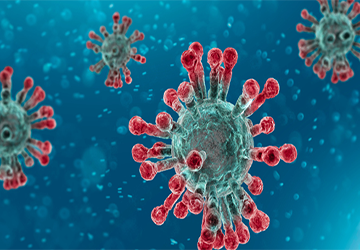A blood infection is also known as sepsis (a condition that occurs when contaminants enter the blood). An invulnerable body is significantly weakened as the body tries to create the best possible protection. This is a life-threatening disease caused by infection. There are more than 200,000 cases in the United States each year. It can be treated in an emergency room. It takes days or weeks to go away.
It is best to seek medical treatment as soon as you become aware of an infection, as it can be life-threatening. Existing health problems included malignancy, ongoing medical intervention, and AIDS. Some people think that a blood infection will go away on its own. Symptoms become unbearable and cause death. Seek immediate medical attention if symptoms develop, even if you do not have any current medical conditions. Here are 14 common signs of a blood infection.

1. Fever
A potential side effect of a blood infection is a febrile reaction. Fever from a blood infection is usually high, well over 38°C. Once there is general irritation of the tissues, the body usually responds with increased body temperature, known as a febrile response.
The motivation behind fevers in humans is to create an environment for microbes they cannot tolerate, thus allowing the indestructible body to crush them and remove them from our bodies. The challenge with fever as a side effect of blood infection is that, for blood infections, it is quite possible to differentiate fever caused by blood infection from fever caused by contamination due to the proximity of microbes in the body.
2. Low cycle pressure
Fever is the most common and first sign of a blood infection. However, the main obstacle to a febrile reaction as a marker of blood infection is that it is a vague response since many different medical conditions, including the disease itself, can cause fever. When the signs become more apparent or no other less common conditions are associated with high internal heat, it is easier and safer to analyze an emerging blood infection.
Therefore, the relationship between fever and other usually unrelated manifestations will make it easier for your GP to understand that your body is suffering from a blood infection. One side effect of bloodstream infections is a low heart rate, which is one reason bloodstream infections require immediate treatment with plenty of fluids. When a blood infection worsens, a miracle called septic stun can occur, the main symptom of which is an unexpected sudden drop in pulse.
3. Abnormal heart volume
Our heart is one of the most important muscles in our body. It sucks blood sixty to eighty times at any moment, ensuring blood flows throughout our bodies and substances get where they need to be. Blood carries all nutritional supplements, oxygen, carbon dioxide, living cells, microbes, toxins, and everything else that needs to be transported between locations, as well as minor components like drugs and germs.
The entire body is negatively affected if the heart is not functioning correctly. In people with a blood infection, changes in the circulatory system and organ degeneration can lead to abnormal heart function. The most persistent deviation from normal in the heart's pumping process associated with a blood infection is called tachycardia, and patients often experience the heart pumping or pumping too fast in the chest. A heartbeat of more than 90 beats per second is normal for a blood infection.
4. Check for low platelet count
Platelets are tiny cells in our circulatory system and are essential to keep us alive. They are one of the critical components in the blood clotting process, which protects our circulatory system from bodily harm. When our tissues rupture from an injury or other physical tear, the veins also rupture, and blood can no longer flow from our body.
Coagulation is a reaction that prevents bleeding by stopping the bleeding. Platelets gather at the break and stick to each other, chains of proteins that form blood clots. This clotting blocks blood flow and keeps it in our body. Certain medical conditions, such as blood infections, can cause our platelet counts to drop, which can be very dangerous because our bodies are not prepared to stop bleeding when we are at risk of injury or injury.
5. Shortness of breath
Our breathing rate can also be affected by blood infections. The speed and depth of our breathing are limited by many muscles in our core, including the abdominal and intercostal muscles. When these muscles relax, our lungs grow, and air moves through our nose or mouth.
Where we inhale, the oxygen that can be felt around where we inhale goes into the lungs and directly into our circulatory system. A separate mechanism in our brain determines the amount of oxygen in our blood. If we don't have enough oxygen in our blood, the body makes us breathe faster to compensate for the lack of oxygen. People with blood infections often live faster than expected, more than twenty breaths per minute, and always have difficulty relaxing.

6. Low body temperature
Our internal heat levels should be within a very narrow range, around 37 degrees Celsius, so that our abilities are used correctly, and medical issues are not identified due to inaccurate internal heat levels and previously reported that fever is the leading indicator of blood infection, a change in the standard internal heat level. Still, the significant internal heat level adjustment is not associated with a blood infection.
A fever is just the body's potential response to a blood infection. The study found that some patients with blood infections had the opposite internal heat level dysregulation. A drop in internal temperature below 36°C is called hypothermia. Patients with hypothermia cannot regulate their body temperature independently and must be kept warm with blankets and a mild heat source.
7. Chills
As mentioned earlier, chills can appear in several places due to a blood infection. So the chills are a side effect of the optional requirement, suggesting they result from another early sign of a blood infection. For example, a drop in circulatory pressure can cause chills and shivering, especially in the lower body. Another possible cause of colds is fever, especially if it is excessive, which is typical for blood infections.
A third possible cause of chills is hypothermia or a strange internal heat breakdown. As programmed components are designed to restore biological homeostasis, muscles automatically begin to tremble as they expend energy, and the metabolic reactions dissipate heat. Severe colds can help restore internal heat levels by making them hotter.
8. Power outage
Loss of consciousness is a sign of a moderate to severe blood infection. When your body gets a blood infection, there are several possible explanations for the loss of consciousness, most of which relate to the infection's effect on your homeostasis and brain composition.
A blood infection can drastically alter the elements of your body, from your blood to your fluid features to your internal heat levels and more. If the discomfort is too extreme, your brain may decide to stop doing it to be less interested in it. Fluids and glucose are becoming more and more scarce in your life form.
A specific cause of coma in blood infection is so-called septic stunning. This occurs in more advanced cases of blood infection. This unexpected blackout is caused by a sudden drop in heart rate, which affects the brain's water system and can lead to loss of consciousness.
9. Mental Gestures
The brain is a sensitive organ with particular glucose, fluid, and oxygen needs. Suppose the organism is altered by some aggregate condition (such as a blood infection). In that case, these requirements cannot be adequately met, so how our brain capabilities are severely limited may change. A blood infection can cause significant and unexpected changes in mental state.
Whereas the correspondence between neurons and various sensory cells depends on the composition and fluid state in which they work. The absolute most fundamental scientific and psychic changes brought on by a blood infection are:
Insanity.
Mental retardation.
The unexpected collapse of mental abilities.
A decline in cognitive levels.
This last sign is reinforced from time to time by another side effect (tiredness), which further impairs mental clarity and alertness and makes it increasingly difficult for patients to think clearly.

10. Pain
Blood infection is a complex disease that affects many parts of the body. At the same time, pain is a summarizing emotion that trains us to realize that something has no direct relationship to our body. Affliction is typical of many diseases, and blood infections are no exception. Bloodstream infection is essential because it is an ill-defined disease that spreads instantly throughout the body, affecting tissues and organs at many points in our lives.
So the pain we feel during a blood infection can show up in different parts of our vital system, although the most common place is the stomach area, as that is where most of our internal organs are located. When the blood becomes infected, the toxic synthetic compounds released cause irritation of the organs and various tissues, so we experience pain in all tissues affected by this condition, especially in the central area.
11. Jaundice
It's a growing sign of organ failure, just as heart palpitations and tachycardia can show tissue failure in our bodies. Jaundice as an indicator can be identified by a noticeable yellowing of the skin on the outside. The whites of the eyes, in particular, can be bright yellow in extreme cases. Jaundice is caused by excess bile, a substance with a characteristic yellow tinge, in our circulatory system.
As bile travels through our bodies, it accumulates in our shallower tissues, giving them the characteristic yellow jaundice hue. Bile is the fluid stored in the gallbladder to help absorb food. If organs such as the gallbladder and liver collapse, bile may be flushed into the circulatory system, increasing its fixation in various body tissues and causing jaundice.
12. Reduced urination
A bloodstream infection is a medical condition requiring clinical attention and medical workup. One reason is how it affects our living beings' liquid elements. No or very little urination is normal when people have a blood infection.
The fluid dynamics in their body are significantly affected, and the recommended treatment for bloodstream infections always involves the injection of large volumes of fluid through an IV or IV catheter. Fluids help kill harmful substances and irresistible microbes that invade the body. Still, the amount of fluid intake typical to blood infections can direly affect a patient's overall performance. A decrease in the total amount of urine excreted from the body is usually a sign that experts must be alert.
13. White or blotchy skin
The tone of our skin is determined by the levels of a specific protein called melanin, which gives it a characteristic dark hue. The more melanin we have, the darker our skin becomes. The role of melanin is to protect our subcutaneous tissue from the sun's harmful radiation. This is why our skin turns dark after sunbathing.
Some medical conditions can alter our skin tone by changing the amount of melanin in the dermis or skin tissue. Definite diseases like Vitiligo are known to destroy melanin, which leaves white or light-colored spots on our skin that can spread in our body in the long run. Blood infections can also affect our skin tone and create less-melanin patches, which can cause unpredictable discoloration on the outside of our bodies.
14. Drowsiness
The whole process of having a septic tank site is surprisingly taxing on the body. It takes a lot of energy to fight the disease. However, power utilization may be reduced if the battle develops into a blood infection. In addition to being biologically exhausted battling the microbes and harmful substances that openly flow through our bodies, a host of side effects can lead to fatigue.
The way these synthetic substances act on our muscles and various tissues causes them to weaken, making it increasingly difficult for us to perform any physical activity, but the effort can be mitigated. In the same way that decreased circulatory pressure can lead to drowsiness and dizziness, the chaos in the brain caused by a blood infection can also make you feel like you won't be able to stay awake and need to rest.